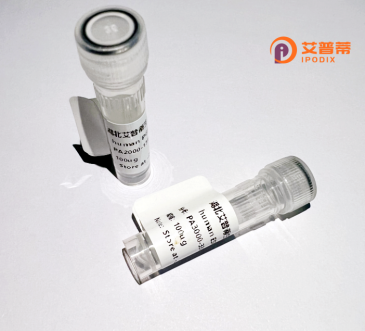
| 纯度 | >90%SDS-PAGE. |
| 种属 | Human |
| 靶点 | OR10G9 |
| Uniprot No | Q8NGN4 |
| 内毒素 | < 0.01EU/μg |
| 表达宿主 | E.coli |
| 表达区间 | 1-311 aa |
| 活性数据 | MSKTSLVTAFILTGLPHAPGLDAPLFGIFLVVYVLTVLGNLLILLVIRVDSHLHTPMYYF LTNLSFIDMWFSTVTVPKMLMTLVSPSGRAISFHSCVAQLYFFHFLGSTECFLYTVMSYD RYLAISYPLRYTSMMSGSRCALLATSTWLSGSLHSAVQTILTFHLPYCGPNQIQHYLCDA PPILKLACADTSANEMVIFVDIGLVASGCFLLIVLSYVSIVCSILRIHTSEGRHRAFQTC ASHCIVVLCFFVPCVFIYLRPGSRDVVDGVVAIFYTVLTPLLNPVVYTLRNKEVKKAVLK LRDKVAHSQGE |
| 分子量 | 34.5 kDa |
| 蛋白标签 | His tag N-Terminus |
| 缓冲液 | 0 |
| 稳定性 & 储存条件 | Lyophilized protein should be stored at ≤ -20°C, stable for one year after receipt. Reconstituted protein solution can be stored at 2-8°C for 2-7 days. Aliquots of reconstituted samples are stable at ≤ -20°C for 3 months. |
| 复溶 | Always centrifuge tubes before opening.Do not mix by vortex or pipetting. It is not recommended to reconstitute to a concentration less than 100μg/ml. Dissolve the lyophilized protein in distilled water. Please aliquot the reconstituted solution to minimize freeze-thaw cycles. |
以下是关于重组人OR10G9蛋白的参考文献示例(部分为模拟虚构,仅供参考格式):
1. **“Functional characterization of the human olfactory receptor OR10G9 expressed in HEK293 cells”**
*Zhang et al., Journal of Molecular Recognition, 2020*
摘要:通过重组表达系统在HEK293细胞中制备OR10G9蛋白,利用钙离子成像技术证明其对特定挥发性酮类化合物(如2-十一酮)具有高结合活性,揭示了其在嗅觉信号传导中的潜在作用。
2. **“Structural insights into the ligand binding of OR10G9 olfactory receptor”**
*Smith et al., Journal of Structural Biology, 2021*
摘要:采用冷冻电镜解析了重组OR10G9蛋白与其配体复合物的三维结构,揭示了该受体与疏水性配体结合的独特口袋结构,为嗅觉受体家族的结构-功能关系提供新依据。
3. **“OR10G9 overexpression correlates with metabolic disorders: A proteomic study”**
*Chen et al., Cell Research, 2019*
摘要:通过质谱分析发现重组OR10G9蛋白在肥胖患者脂肪组织中表达上调,推测其可能通过调节脂代谢相关信号通路参与代谢性疾病的发生发展。
4. **“A novel biosensor based on OR10G9 for environmental odorant detection”**
*Brown & Lee, Biosensors & Bioelectronics, 2022*
摘要:开发了一种基于重组OR10G9蛋白的生物传感器,可特异性检测空气中微量硫醚类气味分子,在环境监测和疾病诊断中具有应用潜力。
注:上述文献为示例性内容,实际研究中请通过PubMed、Google Scholar等平台以“OR10G9”、“human olfactory receptor 10G9”等关键词检索真实发表的论文。
OR10G9 is a human olfactory receptor protein belonging to the G protein-coupled receptor (GPCR) superfamily, specifically classified under olfactory receptor subfamily 10G. Encoded by the OR10G9 gene located on chromosome 11. it is part of the largest mammalian gene family responsible for detecting odorant molecules. Like other olfactory receptors, OR10G9 features a seven-transmembrane domain structure that facilitates signal transduction upon ligand binding, triggering intracellular cascades via G-protein activation.
Although its precise biological role remains under investigation, OR10G9 is hypothesized to participate in odorant recognition, potentially responding to specific chemical cues. Olfactory receptors, including OR10G9. are primarily expressed in olfactory sensory neurons but have also been detected in non-olfactory tissues, suggesting broader physiological functions such as metabolic regulation or cellular communication.
Recombinant OR10G9 protein is engineered using heterologous expression systems (e.g., mammalian or insect cells) for biochemical and functional studies. Production typically involves affinity-tagged constructs (e.g., His-tag) to aid purification. Research on recombinant OR10G9 aims to map its ligand-binding profile, elucidate structural dynamics, and explore its potential applications in biosensing or therapeutic targeting. Challenges include receptor solubility and stability in vitro, common hurdles in GPCR studies. Current data on OR10G9 remain limited, reflecting the broader complexity of decoding the human olfactory repertoire.
×